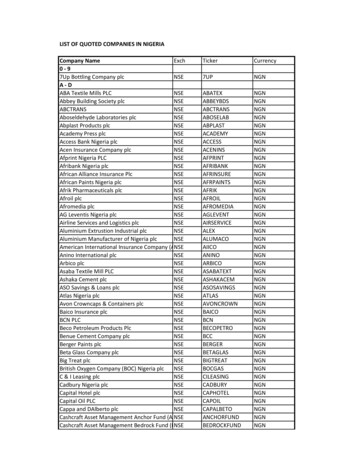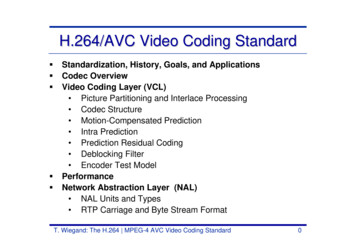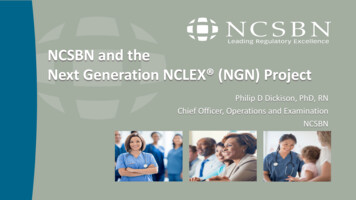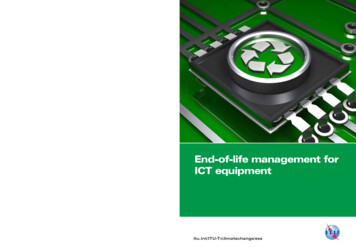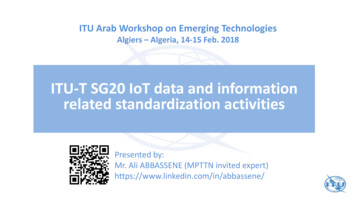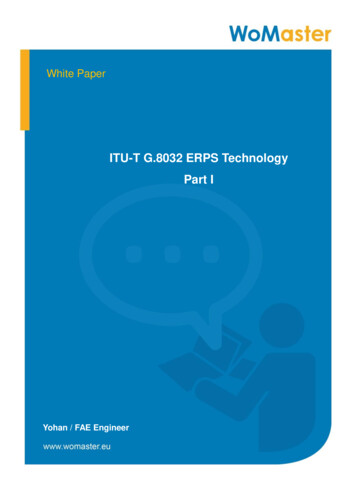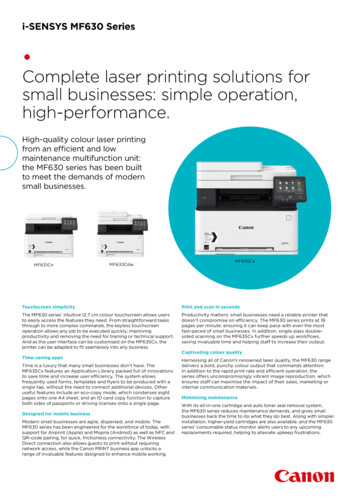
Transcription
Workshop at NGNLABORATORYITU-DDD/MM/AAAA
Day One Workshop at NGN Lab Instrumentation; Protocols: SIP Workshop at NGN LabProtocols: H.248 Workshop at NGN Lab interoperability aspects. SIP-ISUPSIP –I (ITU-T Rec. Q.1912.5 Profile C) Workshop at NGN Lab Voice Quality (PESQ ITU-T Rec. P.862)
Workshop at NGN LabInstrumentation; Protocols: SIPNGN network tests.
SIP protocol test scenarioTests will be run in two groups NGN network tests Tests with test equipmentSERVERCLIENTINVITE/SDP100 TRAINGNGN network tests180 RAING NGN network call SIP protocol – SuccessCase Subscriber A originates call Subscriber B originates call200 OK/SDPACKSPEECH-RTP NGN network call SIP protocol – Failure Case Release: busy Release: congestedBYE200 OK
Topology SIP Protocol10.04.03.201Test M ‐IPWiresharkLoopBackIP Phone7000IP Phone7001
SIP protocol call using the networkSuccess Case – A originatesSERVERCLIENTTEST-1SUCCESS CASESubscriber A originatesScopeVerify how system behaves when subscriber is freeProcedure Subscriber A originates call (soft phone)SIP Protocol, using CODEC G.711From soft phone to IP phoneMonitored via wiresharkObjective Verify how system behaves when interfunctioningVerify success of call completion, communication, and termination, involving NGNelements and correct codec negotiationExpected results: Success completing call, talking and hanging up when subscriber A originates thecallINVITE/SDP100 TRAING180 RAING200 OK/SDPACKSPEECH-RTPBYE200 OK
SIP protocol call using the networkSuccess Case – B originatesSERVERCLIENTTEST-2SUCCESS CASESubscriber B originatesScopeVerify how system behaves when subscriber is freeProcedure Subscriber B originates callSIP Protocol, using CODEC G.711From soft phone to IP phoneMonitored via wiresharkObjective Verify how system behaves when interfunctioningVerify success of call completion, communication, and termination, involving NGNelements and correct codec negotiationExpected results: Success completing call, talking and hanging up when subscriber B originates thecallINVITE/SDP100 TRAING180 RAING200 OK/SDPACKSPEECH-RTPBYE200 OK
SIP protocol call using the networkwith Failure Case – B busyTEST-3FAILURE CASEB busyScopeVerify how system behaves when subscribernumber changedProcedure Originate Call to subscriber B, whose numbermust be busy SIP protocol, using CODEC G.711 From test equipment to IP phone Monitored via wiresharkObjective Verify how system behaves when interfunctioningVerify if caller receives a busy tone and message 486 Busy HereVerify correct mapping of referred causes (ITU reference – Q.850) in therespective SIP messages(Reason:Q.850;cause 17;text "user busy")Expected results on the caller's end: Busy tone Message 486 Busy HereSERVERCLIENTINVITE/SDP100 TRAING486 Busy Here(Reason:Q.850;cause 17;text "User busy")
SIP protocol call using the networkwith Failure Case – B congestedFAILURE CASEB congestedScopeVerify how system behaves whensubscriber number is non-existentProcedure Originate Call to subscriber B, whose numbermust be congested SIP protocol, using CODEC G.711 From test equipment to IP phone Monitored via wiresharkScope Verify how system behaves when interfunctioningVerify if caller receives an empty number tone and message 503 ServiceUnavailable Verify correct mapping of referred causes (ITU reference - Q.850) in therespective SIP messages(Reason:Q.850;cause 34;text "no circuit available")Expected results on the caller's end: Empty number tone(Reason:Q.850;cause 34;text "no circuit 0 TRAING503 Service unavailable(Reason:Q.850;cause 34;text "no circuit available")
Workshop at NGN LabInstrumentation; Protocols: SIP;Tests with test equipment.
SIP protocol test scenarioTests with test equipment NGN network call SIP protocol – Success Case Subscriber A originates callSubscriber B originates call NGN network call SIP protocol – Failure Case Release: number changed Conformance Test ETSI TS 102 027-2 V4.1.1 (2006-07) –Methods for Testing and Specification (MTS);Conformance Test Specification for SIP (IETF RFC3261); SIP CC OE CE V 032SIP CC OE CR V 010SIP CC OE CE TI 003SIP MG TE V 013
Topology SIP ProtocolTest 0SIPH.248SIP10.04.03.205(CHM oopBackIP Phone7000IP Phone7001
SIP protocol call,Failure Case – B number changedTEST-1ScopeFAILURE CASEB number changedSERVERCLIENTINVITE/SDPVerify how system behaves when subscriber fails –22 number changed100 TRAINGProcedureOriginate Call to subscriber B (number changed)SIP protocol, using CODEC G.711From test equipment to IP phoneMonitored via wiresharkObjective Verify how system behaves when interfunctioning Verify if caller receives a busy tone and message 410 GoneVerify correct mapping of referred causes (ITU reference – Q.850) in therespective SIP messages(Reason:Q.850;cause 22;text "number changed")Expected results on the caller's end: Busy tone Message 410 Gone410 GoneReason:Q.850;cause 22;text “number changed")
Conformance Test:SIP CC OE CR V 010 – CANCEL Conformance Test: TPId: SIP CC OE CR V 010Status: MandatoryRef: RFC 3261Purpose: Ensure that the IUT having received a Trying (100 Trying)response to its INVITE request, to give up the call, sends a CANCELrequest.
Conformance Test: SIP CC OE CE V 032(NotFound (404 Not Found)) Conformance Test: TPId: SIP CC OE CE V 032Status: MandatoryRef: RFC 3261Purpose: Ensure that the IUT when an INVITE client transaction is in theCalling state, on receipt of a Not Found (404 Not Found) response sendsan ACK request with the same Call-ID, From headers and Request-URIas in the original INVITE request and the same Tag in the To header as inthis response.
Conformance Test: SIP CC OE CE TI 003– Timer Conformance Test: TPId: SIP CC OE CE TI 003Status: MandatoryRef: RFC 3261Purpose: If an unreliable transport (UDP) is used, ensure that the IUT,when an INVITE client transaction is in the Calling state having alreadyrepeated its INVITE wait for a timer A set with a value of 2*T1 beforesending it again.
Conformance Test:SIP MG TE V 013 – short names Conformance Test: TPId: SIP MG TE V 013Status: MandatoryRef: RFC 3261Purpose: Ensure that the IUT on receipt of an INVITE request includingheaders set with short names, sends a Success (200 OK) responsepreceded optionally by informational (1XX) response.
Day One Workshop at NGN Lab Instrumentation; Protocols: SIP. Workshop at NGN LabProtocols: H.248 Workshop at NGN Lab interoperability aspects. SIP-ISUPSIP –I (ITU-T Rec. Q.1912.5 Profile C) Workshop at NGN Lab Voice Quality (PESQ ITU-T Rec. P.862)
Workshop at NGN LabProtocols:H.248.
Signaling protocol H.248 scenarioFour kinds of tests will be run: MGW alignment Service Change NGN network call H.248 protocol – Success Case Subscriber A originates call Subscriber B originates call H.248 tests with RTP EVENTE NGN network call H.248 protocol – Failure Case Release: busy Release: non-existent
Topology H.248 NGN network, VOICE callTest SystemMGCIP SIPIP5678‐9700SIPH.248H.248(CHM )SIPISDN‐PRIAGWPABX‐IPSIPWiresharkLoopBackIP Phone7000IP Phone7001
H.248 protocol signaling callAlignmentTEST-1ALIGNMENTScopeVerify system behavior when starting upProcedure Remove board and insert it again to verify howsystem behaves when starting up Monitored via wiresharkObjective Verify start up behavior of a new alignment between MGW and MGC, using theService Change commandExpected results: Alignment successful
H.248 protocol signaling callSuccess Case – A originatesTEST-2SUCCESS CASESubscriber A originatesScopeVerify how system behaves when subscriber is freeProcedure Originate Call from IP phone subscriberH.248 protocol, using CODEC G.711From IP phone to soft phoneMonitored via wiresharkObjective Verify how system behaves when interfunctioning Verify success of call completion, communication, and termination, involving NGNelements and correct codec negotiation.Expected results: Success completing call, talking and hanging up when subscriber A originates thecall
H.248 protocol signaling callSuccess Case – B originatesTEST-3SUCCESS CASESubscriber B originatesScopeVerify how system behaves when subscriber is freeProcedure Originate Call from IP phone subscriberH.248 protocol, using CODEC G.711From IP phone to soft phoneMonitored via wiresharkObjective Verify how system behaves when interfunctioning Verify success of call completion, communication, and termination, involving NGNelements and correct codec negotiation.Expected results: Success completing call, talking and hanging up when subscriber B originates thecall
H.248 protocol signaling callSuccess Case – DTMF DigitsTEST-4SUCCESS CASEDTMF DigitsScopeVerify how system behaves when subscriber is freeProcedure Originate Call from IP phone subscriberH.248 protocol, using CODEC G.711From IP phone to IP phoneDigits from 0 to 9 shall be inputMonitored via wiresharkObjective Verify how system behaves when interfunctioning Verify success of call completion, communication, and termination, involving NGNelements and correct codec negotiation Verify digits in RTP eventsExpected results: Success completing call, talking and hanging up when subscriber A originates thecallVerify digits in RTP events
H.248 protocol callFailure Case – Subscriber B busyTEST-5FAILURE CASEReceiver must be busyScopeVerify how system behavessubscriber number is busy.Procedure Originate Call to subscriber B, whose numbermust be busy H.248 protocol, using CODEC G.711 From test equipment to IP phone Monitored via wiresharkwhenObjective Verify how system behaves when interfunctioning Verify if caller receives a busy tone and the message Subtract , Verify correct mapping of referred causes (ITU reference - Q.931) in therespective ISDN messages, cause 17.(Reason:Q.931;cause 17;text "user busy").Expected results on the caller's end: Busy tone Message CAUSE# 17 User busyreceiving
H.248 protocol call using the networkFailure Case – B congestedSERVERCLIENTTEST-6Failure CaseB congestedScopeVerify how system behaves whensubscriber number is non-existentProcedure Originate Call to subscriber B, whose numbermust be congested H.248 protocol, using CODEC G.711 From test equipment to IP phone Monitored via wiresharkreceivingINVITE/SDP100 TRAING503 Service unavailableObjective Verify how system behaves when interfunctioning Verify if caller receives an empty number tone and message 486 Busy Here , Verify correct mapping of referred causes (ITU reference - Q.931) in therespective release messages(Reason:Q.931;cause 34;text "no circuit available")Expected results on the caller's end: Empty number tone(Reason:Q.931;cause 34;text "no circuit available")(Reason:Q.931;cause 34;text "nocircuit available")
Day Two Workshop at NGN Lab Instrumentation; Protocols: SIP. Workshop at NGN LabProtocols: H.248 Workshop at NGN Lab interoperability aspects. SIP-ISUPSIP –I (ITU-T Rec. Q.1912.5 Profile C) Workshop at NGN Lab Voice Quality (PESQ ITU-T Rec. P.862)
Workshop at NGN Lab interoperabilityaspects. SIP-ISUP, SIP-I(ITU-T Rec. Q.1912.5 Profile C).
SIP-l protocol test scenarioTests with test equipmentNGN network call SIP-l protocol CODEC G.711A success case Subscriber A originates callSubscriber B originates call CODEC G.729A success case Subscriber A originates callSubscriber B originates call Failure Case Release: busyRelease: congested
Topology SIP-l ProtocolTest �9700SIPH.248(CHM IPWiresharkSIPLoopBackIP Phone7000IP Phone7001
Signaling call SIP-l protocol – Success CaseSubscriber A originates CODEC-G.711SERVERCLIENTTEST-1SUCCESS CASEFrom A, CODEC-G.711ScopeVerify how system behaves when subscriber is freeProcedure Subscriber A originates a callProtocol SIP-l, using CODEC G.711From test equipment to IP phoneMonitored via wiresharkINVITE-SDP/ IAM100 TRAING180 RAING/ ACM200 OK-SDP/ ANMObjective Verify how system behaves when interfunctioning Verify success of call completion and termination, involving NGN elementsACKExpected results: Success completing call, correct codec negotiation and termination.BYE / RELEASE200 OK/ RLC
Signaling call SIP-l protocol – Success CaseSubscriber B originates CODEC-G.711SERVERCLIENTTEST-2SUCCESS CASEFrom A, CODEC-G.711ScopeVerify how system behaves when subscriber is freeProcedure Subscriber B originates a callProtocol SIP-l, using CODEC G.711From test equipment to IP phoneMonitored via wiresharkObjective Verify how system behaves when interfunctioning Verify success of call completion and termination, involving NGN elementsINVITE-SDP/ IAM100 TRAING180 RAING/ ACM200 OK-SDP/ ANMACKExpected results: Success completing call, correct codec negotiation and termination.BYE / RELEASE200 OK/ RLC
Signaling call SIP-l protocol – Success CaseSubscriber A originates CODEC-G.729SERVERCLIENTTEST-3SUCCESS CASEFrom A, CODEC-G.729ScopeVerify how system behaves when subscriber is freeProcedure Subscriber A originates a callProtocol SIP-l, using CODEC G.729From test equipment to IP phoneMonitored via wiresharkObjectiveINVITE-SDP/ IAM100 TRAING180 RAING/ ACM200 OK-SDP/ ANM Verify how system behaves when interfunctioning Verify success of call completion and termination, involving NGN elementsACKExpected results: Success completing call, correct codec negotiation and termination.BYE / RELEASE200 OK/ RLC
Signaling call SIP-l protocol – Success CaseSubscriber B originates CODEC-G.729SERVERCLIENTTEST-4SUCCESS CASEFrom B, CODEC-G.729ScopeVerify how system behaves when subscriber is freeProcedure Subscriber B originates a callProtocol SIP-l, using CODEC G.729From test equipment to IP phoneMonitored via wiresharkINVITE-SDP/ IAM100 TRAING180 RAING/ ACM200 OK-SDP/ ANMObjectiveACK Verify how system behaves when interfunctioning Verify success of call completion and termination, involving NGN elementsExpected results: Success completing call, correct codec negotiation and termination.BYE / RELEASE200 OK/ RLC
Signaling call SIP-l protocolFailure Case – B BusyCLIENTTEST-5FAILURE CASEB BusyScopeVerify how system behavessubscriber number is busy.Procedure If making an IP phone call, test equipment mustreceive it Protocol SIP-l, using CODEC G.711 Monitored via wiresharkwhenreceivingSERVERINVITE-SDP/ IAM100 TRAING486 Busy Here / REL #17Objective Verify how system behaves when interfunctioning Verify message 486 Busy Here Verify correct mapping of referred causes (ITU reference – Q.850) in therespective SIP messages(Reason: Q.850;cause 17;text "user busy").Expected results: Busy tone Message 486 Busy Here / REL #17
SIP-l protocol callFailure Case – B congestedFAILURE CASEB congestedScopeVerify how system behaves whensubscriber number is non-existentProcedure: Originate call to subscriber B, whose numbermust be congested SIP protocol, using CODEC G.711 From test equipment to IP phone Monitored via wiresharkreceivingObjective Verify how system behaves when interfunctioning Verify if caller receives an empty number tone and message 486 Busy Here Verify correct mapping of referred causes (ITU reference – Q.850) in therespective SIP messages(Reason:Q.850;cause 34;text “no circuit available”)Expected results on the caller's end: Empty number tone(Reason:Q.850;cause 34;text “no circuit available”)SERVERCLIENTTEST-6INVITE/ IAM SDP100 TRAING503 Service unavailable(Reason:Q.850;cause 34;text “no circuitavailable”)
Day Two Workshop at NGN Lab Instrumentation; Protocols: SIP. Workshop at NGN LabProtocols: H.248 Workshop at NGN Lab interoperability aspects. SIP-ISUPSIP –I (ITU-T Rec. Q.1912.5 Profile C) Workshop at NGN Lab Voice Quality (PESQ ITU-T Rec. P.862)
Workshop at NGN Lab VoiceQuality (PESQ ITU-T Rec. P.862)
Voice Quality MeasurementScenario – MOSTwo test cases will be run:Case 1: VOICE calls (female and male sentences, SIP-ISDNprotocol, using codec G.711Case 1: VOICE calls (female and male sentences, SIP-ISDNprotocol, using codec G.729
SIP-ISDN calls test topology, with voicequality measurement – MOSWiresharkTest SystemCodecG.711ASIP Protocol,SIP Protocol,SIPETHIPMOS‐PESQELASTIXRTPSISDN ProtocolISDNE1Perceptual Evaluation of SpeechQuality (PESQ) in standard P.862
MOS Tests with CODEC G.711TEST-1ScopeProcedureMOS testsG.711withCODECVerify call completion and mos Mos measurements forcodec G.711 Simultaneous SIP calls shall be made, originatingfrom test equipment, with male and femalesentences, to be received by the IP-PABX The PABX-IP shall forward the calls to the ISDNroute, to be answered by the test equipment CODEC G.711 From SIP test equipment, passing through the IPPABX, to be received by the ISDN test equipment. Monitored via wiresharkTESTERSIPPABXINVITE/SDPSETUP100 TRAING180 RAING200 OK/SDPACKObjective Verify how system behaves when interfunctioningVerify call completionVerify results of MOS FROM MOS scoreVerify packet loss jitter delayTESTERISDNSPEECHRTPBYECALL Expected Results: Complete calls (without loss) Mos SCORE within satisfactory standards200 OKRLC
MOS Tests with CODEC G.729TEST-2ScopeProcedureMOS testsG.729withCODECVerify call completion and mos Mos measurements forcodec G.729 Simultaneous SIP calls shall be made, originatingfrom test equipment, with male and femalesentences, to be received by the IP-PABX The PABX-IP shall forward the calls to the ISDNroute, to be answered by the test equipment CODEC G.729 From SIP test equipment, passing through the IPPABX, to be received by the ISDN test equipment Monitored via wiresharkTESTERSIPINVITE/SDPSETUP100 TRAING180 RAING200 OK/SDPACKObjective Verify how system behaves when interfunctioningVerify call completionVerify results of MOS FROM MOS scoreVerify packet loss jitter delayTESTERISDNPABXSPEECHRTPBYECALL Expected Results: Complete calls (without loss) Mos SCORE within satisfactory standards200 OKRELC
Thanks! NomeNomeNome Área (UA) Converged Networks CorporateDepartment – DRCPhone: ( 55) 19 3705-XXXXxxxxxxx@cpqd.com.brwww.cpqd.com.br
Conformance Test: SIP_CC_OE_CE_TI_003 -Timer Conformance Test: TPId: SIP_CC_OE_CE_TI_003 Status: Mandatory Ref: RFC 3261 Purpose: If an unreliable transport (UDP) is used, ensure that the IUT, when an INVITE client transaction is in the Calling state having already repeated its INVITE wait for a timer A set with a value of 2*T1 before

